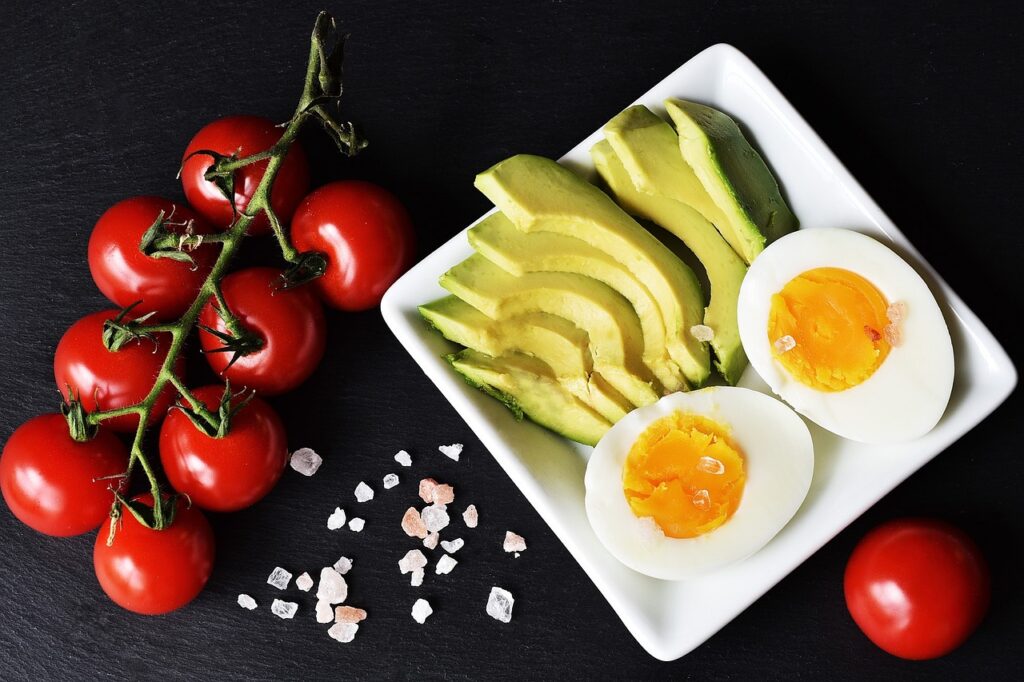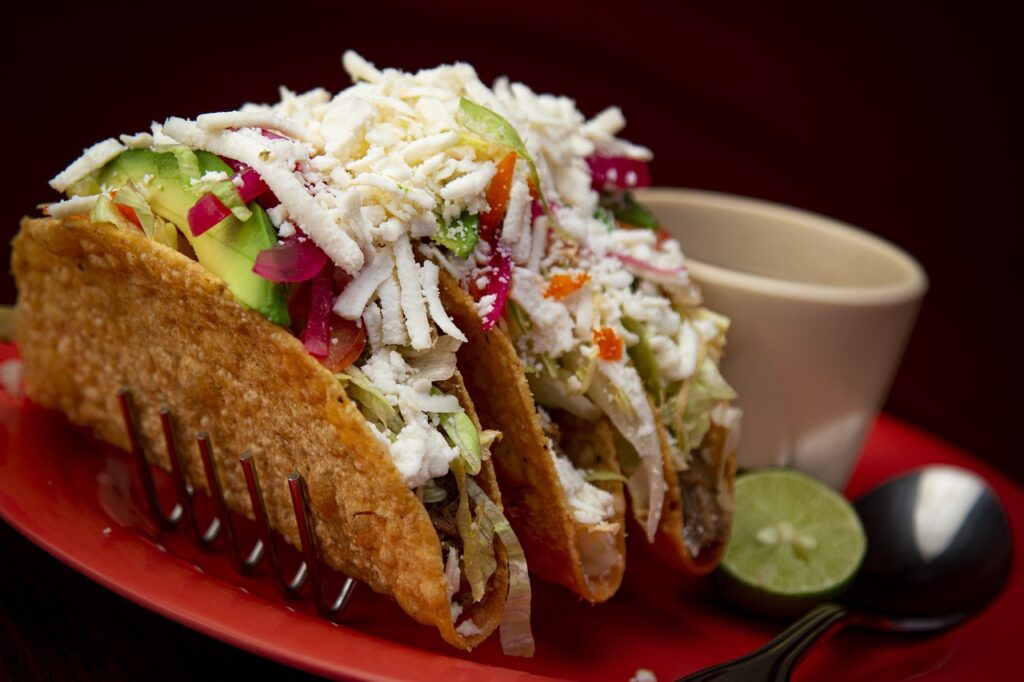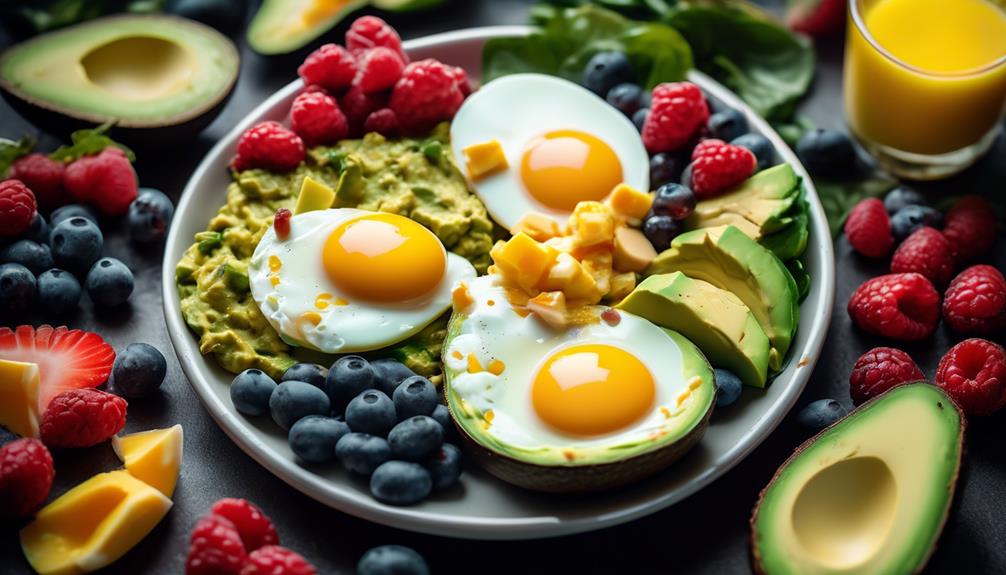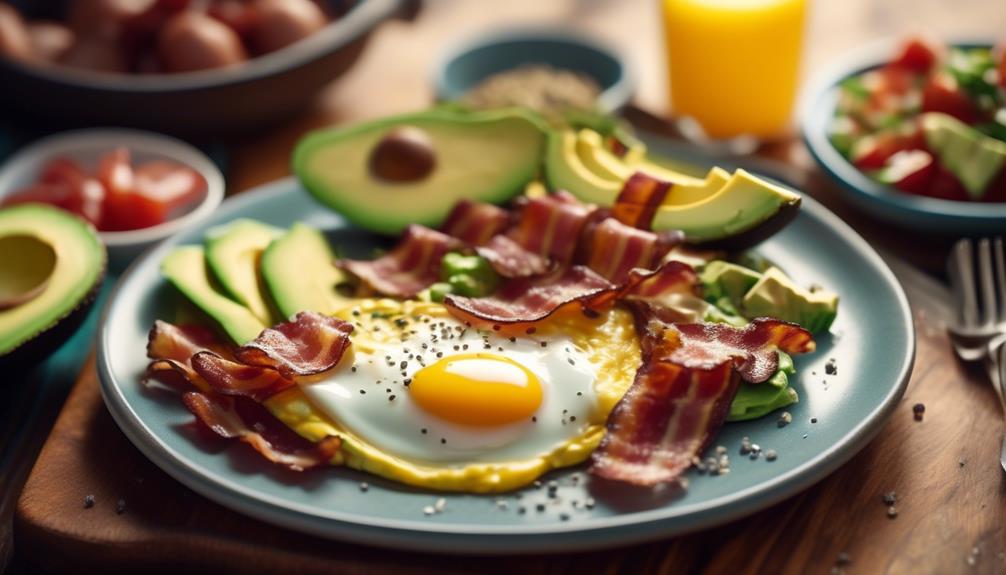Did you know that over 30% of adults in the United States skip breakfast? Starting your day with a nutritious meal can set the tone for a productive and energized day ahead.
If you're looking for a delicious and low-carb way to fuel your mornings, then you've come to the right place. In this guide, we will explore a variety of mouthwatering low-carb breakfast smoothie recipes that are not only easy to make but also packed with essential nutrients.
Whether you're aiming to lose weight, maintain a healthy lifestyle, or simply want to try something new, these recipes are sure to satisfy your taste buds and keep you feeling full until lunchtime.
So, grab your blender and get ready to embark on a flavorful journey that will leave you wanting more.
Benefits of Low-Carb Breakfast Smoothies

Low-carb breakfast smoothies offer a multitude of benefits for those seeking a nutritious and convenient way to start their day. These smoothies aren't only delicious but also packed with essential nutrients that can help you stay energized and satisfied throughout the morning.
One of the main benefits of low-carb breakfast smoothies is their ability to support weight loss. By reducing the amount of carbohydrates in your morning meal, you can help regulate blood sugar levels and promote fat burning. Additionally, low-carb smoothies can help control cravings and prevent overeating later in the day.
Another advantage of low-carb breakfast smoothies is their ability to provide a quick and easy source of nutrients. By blending together a variety of fruits, vegetables, and protein-rich ingredients, you can create a well-rounded meal in just minutes. This is particularly beneficial for those with busy schedules who may not have time to prepare a traditional breakfast.
Furthermore, low-carb smoothies can be customized to suit individual tastes and dietary preferences. There are countless creative low-carb smoothie recipes available, allowing you to experiment with different flavors and ingredients.
Essential Ingredients for Low-Carb Smoothies
Including a variety of nutrient-rich ingredients is essential for creating a satisfying and nutritious low-carb smoothie. When it comes to low-carb smoothie recipes with citrus flavors, you have plenty of options to choose from. Citrus fruits like oranges, lemons, and limes not only add a refreshing tang to your smoothie but also provide a good dose of vitamin C and other antioxidants. You can also incorporate citrus zest for an extra burst of flavor.
If you're looking for low-carb smoothie recipes with dairy alternatives, there are several options available. Unsweetened almond milk or coconut milk are great choices that add a creamy texture without the extra carbs. You can also opt for coconut yogurt or almond yogurt as a substitute for traditional dairy yogurt.
To add protein to your low-carb smoothie, you can use ingredients like Greek yogurt, tofu, or protein powder. These options not only provide protein but also help to keep you feeling full and satisfied.
When it comes to sweetening your low-carb smoothie, it's important to choose options that won't spike your blood sugar. Stevia, erythritol, or monk fruit sweeteners are all low-carb alternatives to sugar that can be used in moderation.
Remember to experiment with different combinations of ingredients to find the flavors and textures that you enjoy the most. By including these essential ingredients, you can create delicious and nutritious low-carb smoothies to start your day on the right foot.
Choosing the Right Base for Your Smoothie
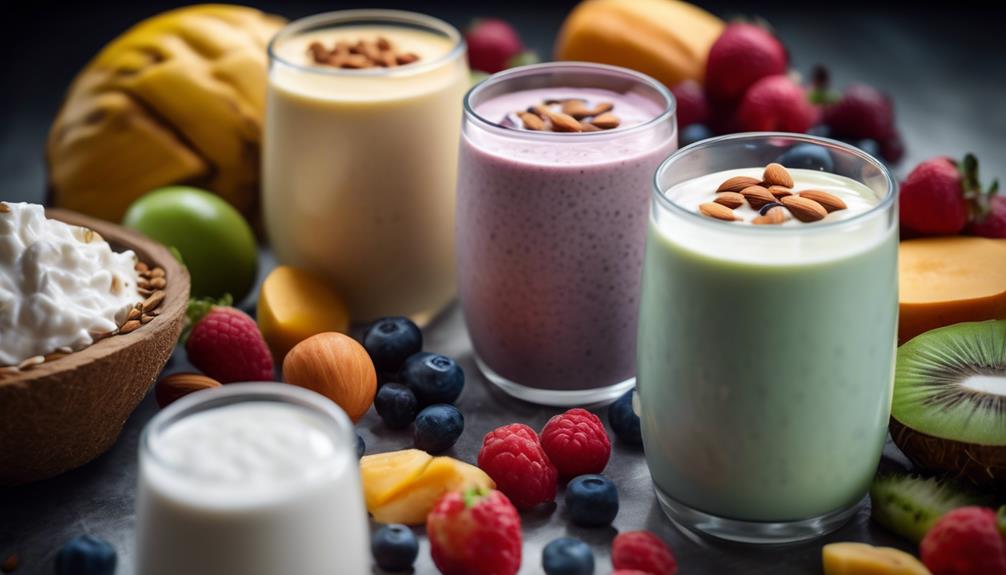
Now let's move on to the next important aspect of creating a satisfying low-carb smoothie: choosing the right base.
The base of your smoothie is what gives it that creamy texture and helps bind all the ingredients together. When it comes to low-carb smoothies, you want to choose a base that isn't only low in carbohydrates but also adds nutritional value to your drink.
One popular and nutritious option for a low-carb smoothie base is unsweetened almond milk. It's low in calories and carbohydrates, making it an excellent choice for those watching their carb intake. Almond milk is also rich in vitamin E, which is important for healthy skin and immune function.
Another creative low-carb smoothie base is coconut milk. It adds a delightful tropical flavor to your smoothie while also providing healthy fats. Coconut milk contains medium-chain triglycerides (MCTs), which are easily digested and can be used as an energy source by your body.
If you're looking for a protein boost, consider using Greek yogurt as your smoothie base. It's low in carbohydrates and high in protein, which can help keep you feeling full and satisfied throughout the morning.
Adding Protein to Your Low-Carb Smoothie
To ensure you're getting enough protein in your low-carb smoothie, there are several options you can consider. Adding protein to your smoothie not only helps keep you full and satisfied, but it also supports muscle growth and repair. Here are three protein sources you can incorporate into your low-carb smoothie:
- Greek Yogurt: Greek yogurt is an excellent source of protein, with around 15-20 grams per serving. Choose plain, unsweetened Greek yogurt to keep the carb content low. You can also opt for dairy-free alternatives like almond or coconut milk yogurt if you're lactose intolerant or following a vegan diet.
- Nut Butter: Nut butters like almond butter or peanut butter not only add a delicious flavor to your smoothie but also provide a good amount of protein. Aim for natural nut butters without added sugars or oils. Two tablespoons of nut butter typically contain about 7-8 grams of protein.
- Protein Powder: Protein powder options are plentiful, ranging from whey protein to plant-based varieties like pea protein or hemp protein. Choose a low-carb protein powder with at least 20 grams of protein per serving. Be mindful of added sugars and artificial ingredients.
Sweetening Options for Low-Carb Smoothies
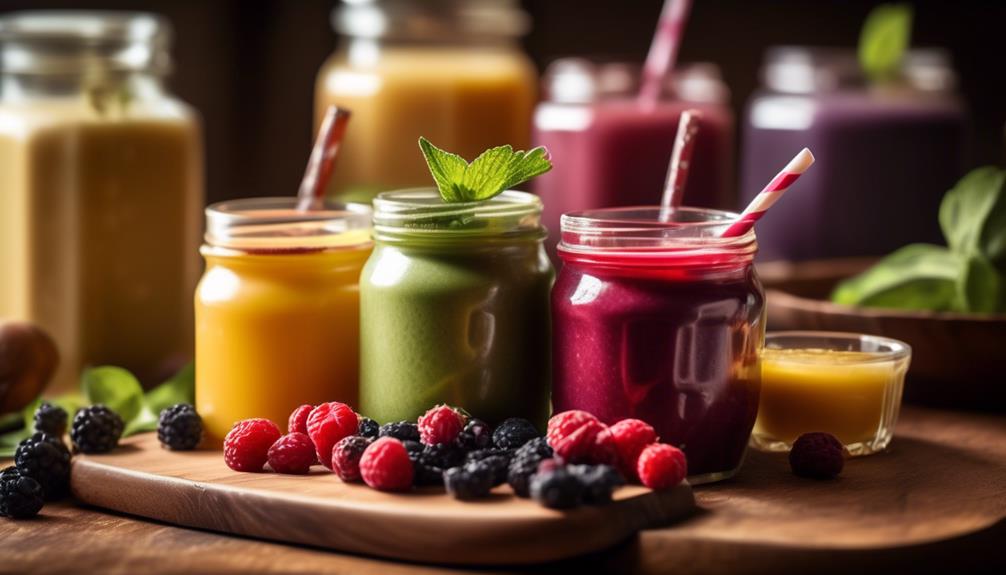
When it comes to sweetening low-carb smoothies, there are a few options to consider.
One option is to use natural low-carb sweeteners like stevia or monk fruit extract, which provide sweetness without adding any carbohydrates.
Another option is to use sugar alternatives such as erythritol or xylitol, which have a minimal impact on blood sugar levels.
It's important to find the right balance of sweetness and flavor to ensure your low-carb smoothie is enjoyable without compromising your dietary goals.
Natural Low-Carb Sweeteners
Looking for a natural low-carb sweetener to add a touch of sweetness to your low-carb smoothies? Here are three options that can satisfy your sweet tooth without spiking your blood sugar levels:
- Stevia: Stevia is a popular natural sweetener derived from the leaves of the Stevia rebaudiana plant. It contains zero calories and has a sweet taste without the bitter aftertaste associated with some artificial sweeteners. Stevia is also a low-carb baking substitute, making it a versatile choice for your smoothies.
- Erythritol: Erythritol is a sugar alcohol that occurs naturally in some fruits and fermented foods. It has a sweet taste but doesn't raise blood sugar levels or contribute to tooth decay. Erythritol is also low in calories and easily digestible, making it an excellent option for those following a low-carb diet.
- Monk Fruit Extract: Monk fruit extract is derived from the monk fruit, a small melon-like fruit native to Southeast Asia. It contains natural compounds called mogrosides, which provide sweetness without adding calories or carbohydrates. Monk fruit extract is a great alternative to sugar and can be used in moderation to sweeten your low-carb smoothies.
These natural sweeteners can be a healthier choice for adding sweetness to your low-carb smoothies without the negative effects of traditional sugar. Experiment with these options to find the one that suits your taste preferences.
Sugar Alternatives for Smoothies
There are several sugar alternatives available that can be used to sweeten your low-carb smoothies.
One popular option is stevia, a natural sweetener derived from the stevia plant. Stevia is much sweeter than sugar, so a little goes a long way.
Another option is erythritol, a sugar alcohol that has a similar taste to sugar but doesn't affect blood sugar levels. It's also lower in calories than sugar.
Monk fruit extract is another sugar alternative that can be used in smoothies. It's derived from the monk fruit and provides a natural sweetness without the carbohydrates.
When choosing a sugar alternative for your low-carb smoothies, be sure to read labels and choose one that fits your dietary needs and preferences.
Balancing Sweetness and Flavor
To balance the sweetness and enhance the flavor of your low-carb smoothies, there are various options available. Experimenting with flavors can help you find the perfect combination that suits your taste buds.
Here are three ways you can achieve sweetness and texture in your low-carb smoothies:
- Berries: Adding fresh or frozen berries, such as strawberries, blueberries, or raspberries, can provide a natural sweetness while adding a burst of flavor.
- Nut butters: Peanut butter, almond butter, or cashew butter can add a creamy texture and a hint of sweetness to your smoothie. Be sure to choose natural, unsweetened options to keep the carb count low.
- Spices: Cinnamon, nutmeg, or vanilla extract can enhance the flavor of your smoothie without adding any extra sweetness. These spices can provide depth and warmth to your low-carb creation.
Boosting Fiber Content in Your Smoothie
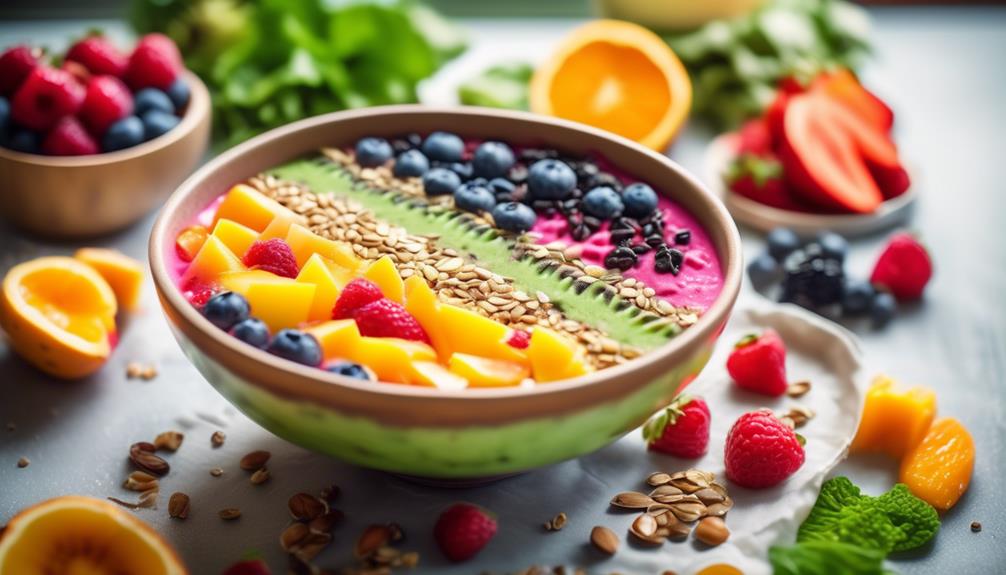
To boost the fiber content in your smoothie, consider adding fiber-rich ingredients such as chia seeds, flaxseed, or spinach. These ingredients not only provide a good amount of fiber but also offer other nutritional benefits.
When blending your smoothie, make sure to blend thoroughly to break down the fiber and create a smooth texture.
Adding fiber to your smoothie can help promote digestion, regulate blood sugar levels, and keep you feeling full and satisfied throughout the morning.
Fiber-Rich Ingredient Options
Incorporate fiber-rich ingredients into your breakfast smoothie for a nutritious and satisfying start to your day. Boosting fiber intake is important for maintaining a healthy digestive system and promoting feelings of fullness. By incorporating healthy fats into your smoothie, you can further enhance the nutritional value and satiety of your breakfast.
Here are three fiber-rich ingredient options to consider:
- Chia seeds: These tiny seeds are packed with fiber and can absorb liquid, creating a gel-like consistency that adds thickness to your smoothie.
- Flaxseeds: High in fiber and omega-3 fatty acids, flaxseeds can help regulate digestion and promote heart health.
- Avocado: Not only does avocado provide healthy fats, but it also contains fiber. Its creamy texture makes it a great addition to any smoothie.
Including these fiber-rich ingredients in your breakfast smoothie won't only boost your fiber intake but also provide a delicious and nutritious start to your day.
Blending Techniques for Fiber
Consider utilizing blending techniques to increase the fiber content in your smoothie for a healthier and more satisfying start to your day.
Blending is a great way to incorporate fiber-rich ingredients into your smoothie. One technique is to add whole fruits and vegetables with their skins intact, such as apples, pears, and cucumbers. These skins contain a significant amount of fiber.
Another technique is to include nuts and seeds like chia seeds, flaxseeds, and almonds. These ingredients not only add fiber but also provide healthy fats and protein.
Additionally, you can try blending in oats or bran for an extra boost of fiber. Remember to blend your smoothie thoroughly to ensure all the fiber-rich ingredients are well incorporated.
Benefits of Adding Fiber
Adding fiber to your breakfast smoothie can offer numerous health benefits and enhance the nutritional value of your morning meal. Here are three reasons why boosting the fiber content in your smoothie is a smart choice:
- Boosting Digestion: Fiber plays a crucial role in promoting healthy digestion. It adds bulk to your stool, making it easier to pass through your digestive system and reducing the risk of constipation. By including fiber in your breakfast smoothie, you can support regular bowel movements and maintain a healthy gut.
- Promoting Satiety: Fiber is known to keep you feeling fuller for longer. By including high-fiber ingredients like chia seeds, flaxseeds, or oats in your smoothie, you can increase its satiety factor. This can help prevent overeating and unnecessary snacking throughout the day, ultimately supporting your weight management goals.
- Maintaining Blood Sugar Levels: Fiber slows down the absorption of sugar into your bloodstream, preventing sudden spikes in blood sugar levels. This is particularly beneficial for individuals with diabetes or those looking to manage their blood sugar levels. Including fiber-rich fruits and vegetables in your smoothie can help regulate your blood sugar levels and provide a steady source of energy throughout the morning.
Incorporating Healthy Fats in Your Smoothie
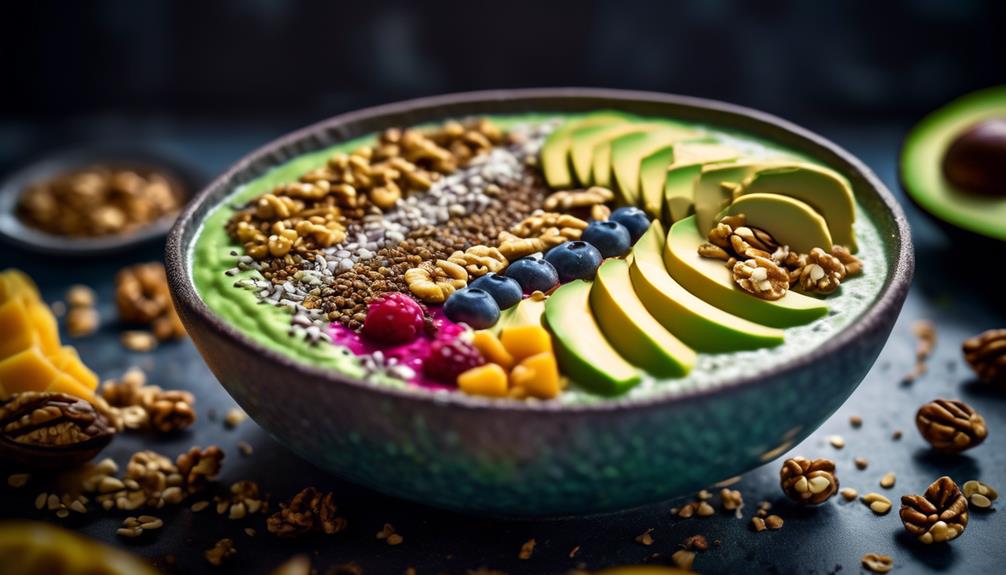
To enhance the nutritional value of your breakfast smoothie, it's beneficial to include a variety of healthy fats. Healthy fats provide numerous benefits for your body, including improved heart health, increased satiety, and better nutrient absorption.
One way to incorporate healthy fats into your smoothie is by adding nuts. Nuts are an excellent source of healthy fats, such as monounsaturated and polyunsaturated fats. These fats have been shown to reduce the risk of heart disease and lower bad cholesterol levels. Nuts also contain fiber, vitamins, minerals, and antioxidants, making them a nutritious addition to your smoothie.
When incorporating nuts into your smoothie, it's important to choose the right type and quantity. Almonds, walnuts, and cashews are popular options that provide a good balance of healthy fats. Start by adding a small handful of nuts to your smoothie and adjust the amount based on your taste preferences.
To ensure the smoothie has a creamy texture, you can soak the nuts overnight or use nut butter instead. Nut butter adds richness and flavor to your smoothie while still providing the benefits of healthy fats. Just be mindful of portion sizes, as nuts and nut butter are calorie-dense.
Including healthy fats in your breakfast smoothie can help you feel fuller for longer and provide essential nutrients. So, grab your blender and start experimenting with different combinations to create a delicious and nutritious smoothie to start your day off right.
Low-Carb Smoothie Recipes With Berries
When it comes to low-carb smoothie recipes, incorporating berries can be a delicious and nutritious choice.
Berries are packed with antioxidants and fiber, which can help support overall health and digestion.
Some popular berry options for smoothies include strawberries, blueberries, raspberries, and blackberries.
Benefits of Berries
Berries offer numerous health benefits and make a delicious addition to low-carb smoothie recipes. Here are three reasons why incorporating berries into your diet can be beneficial:
- Benefits of antioxidants: Berries are packed with antioxidants, which help protect your body against harmful free radicals. These antioxidants have been linked to reducing the risk of chronic diseases such as heart disease, cancer, and neurodegenerative disorders.
- Importance of portion control: While berries are a nutritious choice, it's important to practice portion control. While they're low in carbs, they still contain natural sugars. Adding a moderate amount of berries to your smoothie can add flavor and nutrients without significantly increasing the carb content.
- Nutrient-rich profile: Berries aren't only low in carbs, but they're also high in fiber, vitamins, and minerals. They're a great source of vitamin C, manganese, and folate, which are essential for maintaining a healthy immune system, promoting healthy skin, and supporting brain function.
Incorporating berries into your low-carb smoothie recipes can't only enhance the flavor but also provide numerous health benefits. Just remember to practice portion control and enjoy them as part of a balanced diet.
Berry Smoothie Ingredients
Incorporating a variety of ingredients into your low-carb smoothie can create a delicious and nutritious breakfast option.
When it comes to berry smoothies, there are endless possibilities for boosting antioxidants and creating creative flavor combinations. Berries like strawberries, blueberries, raspberries, and blackberries are packed with vitamins, minerals, and antioxidants that can support your overall health.
They're low in carbs and high in fiber, making them a great choice for a low-carb smoothie base. You can also add ingredients like spinach or kale for an extra nutrient boost.
To sweeten your smoothie without adding extra carbs, you can use natural sweeteners like stevia or monk fruit. Get creative and experiment with different combinations of berries, greens, and sweeteners to find your perfect low-carb berry smoothie recipe.
Blending Techniques
To achieve the perfect texture and flavor in your low-carb berry smoothie, mastering the art of blending is key. Here are some blending tips to help you achieve the smoothie consistency you desire:
- Start with a powerful blender: A high-quality blender will ensure that all the ingredients are thoroughly blended, resulting in a smooth and creamy smoothie.
- Add liquid first: Pour your liquid base, such as almond milk or coconut water, into the blender before adding the other ingredients. This will help the blades blend everything evenly and prevent any chunky bits.
- Blend in stages: To avoid over-blending or leaving chunks behind, blend your smoothie in stages. Start by pulsing the blender a few times, then gradually increase the speed until you reach your desired consistency.
Low-Carb Smoothie Recipes With Leafy Greens
Including leafy greens in your low-carb smoothie recipe can provide a nutritious and refreshing start to your day. Not only are leafy greens low in carbohydrates, but they're also packed with essential nutrients like vitamins A, C, K, and folate, as well as minerals like iron and calcium. If you're looking for alternatives to traditional leafy greens like spinach or kale, consider trying Swiss chard, collard greens, or even beet greens. These options offer similar health benefits and can add a unique twist to your smoothie.
When it comes to creative leafy greens combinations, the possibilities are endless. You can mix spinach with cucumber and mint for a refreshing and hydrating smoothie, or blend kale with avocado and lemon for a creamy and citrusy treat. Another great option is to combine arugula with pineapple and ginger for a zesty and tropical flavor profile. Don't be afraid to experiment and find the combinations that you enjoy the most.
To make your low-carb smoothie even more nutritious, consider adding a source of protein like Greek yogurt or protein powder. This will help keep you full and satisfied throughout the morning. Remember to also include a healthy fat like avocado or coconut oil to promote satiety and support nutrient absorption.
With a little creativity and the inclusion of leafy greens, you can create a delicious and low-carb breakfast smoothie that will fuel your day.
Low-Carb Smoothie Recipes With Nuts and Seeds
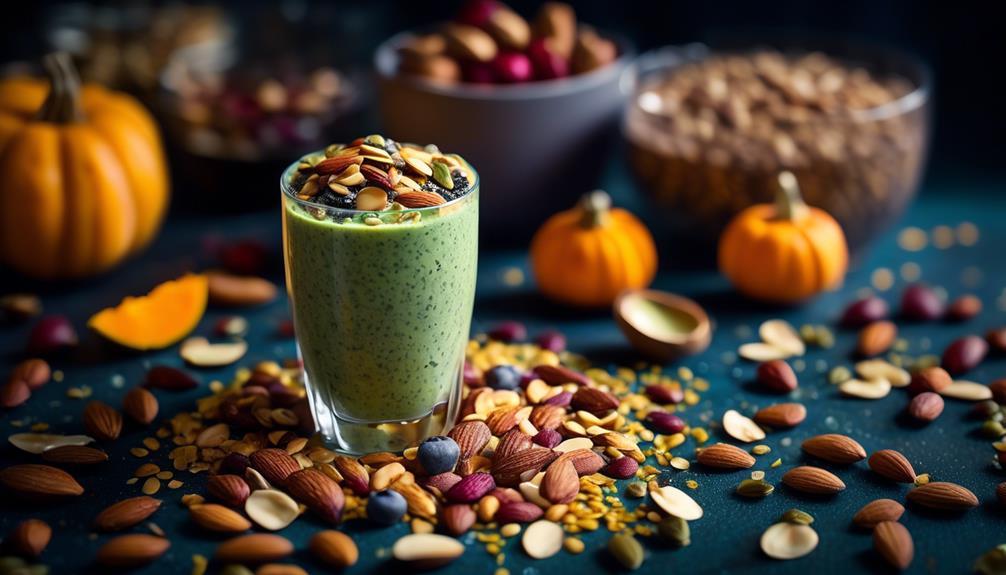
Adding nuts and seeds to your low-carb smoothie recipes can provide a nutritious boost of protein, healthy fats, and essential vitamins and minerals. These low carb smoothie toppings not only enhance the texture and taste of your smoothies but also add an extra nutritional punch.
Here are three reasons why you should consider adding nuts and seeds to your smoothies:
- Protein Powerhouse: Nuts and seeds are packed with protein, making them a great addition to your low-carb smoothies. Protein helps to keep you feeling fuller for longer and aids in muscle repair and recovery. By adding nuts and seeds to your smoothies, you can easily increase your protein intake without adding unnecessary carbs.
- Healthy Fats: Nuts and seeds are rich sources of healthy fats, such as omega-3 fatty acids and monounsaturated fats. These fats are essential for brain health, heart health, and overall well-being. Including nuts and seeds in your smoothies can help you meet your daily fat requirements while following a low-carb diet.
- Essential Nutrients: Nuts and seeds are also packed with essential vitamins and minerals, such as magnesium, zinc, vitamin E, and B vitamins. These nutrients play a crucial role in supporting your immune system, promoting healthy skin, and boosting energy levels.
When it comes to choosing nuts and seeds for your smoothies, options like almonds, walnuts, chia seeds, flaxseeds, and hemp seeds are excellent choices. Remember to use them in moderation and adjust the portion sizes to fit your individual dietary needs. Enjoy the added texture, flavor, and nutritional benefits that nuts and seeds can bring to your low-carb smoothies!
Low-Carb Smoothie Recipes With Avocado
Are you looking for a delicious and nutritious low-carb smoothie recipe? Look no further than incorporating avocado into your blend! Avocado is a versatile fruit that adds a creamy texture and a dose of healthy fats to your smoothies. There are countless avocado smoothie variations that you can try to suit your taste preferences and dietary needs.
One creative avocado smoothie combination is the Avocado Spinach Smoothie. Simply blend one ripe avocado, a handful of spinach, a cup of unsweetened almond milk, and a scoop of vanilla protein powder. This smoothie is packed with nutrients like fiber, vitamins, and minerals, making it a great choice for a low-carb breakfast.
Another delicious option is the Avocado Berry Smoothie. Blend half an avocado, a cup of mixed berries, a tablespoon of chia seeds, and a cup of unsweetened coconut milk. This smoothie is rich in antioxidants and healthy fats, providing you with sustained energy throughout the day.
If you're craving something tropical, try the Avocado Pineapple Smoothie. Blend one ripe avocado, a cup of frozen pineapple chunks, a tablespoon of coconut oil, and a cup of unsweetened almond milk. This smoothie isn't only low in carbs but also high in fiber and vitamin C.
Incorporating avocado into your low-carb smoothies is a great way to add creaminess and healthy fats. Get creative with different combinations and enjoy a delicious and nutritious start to your day!
Low-Carb Smoothie Recipes With Chocolate Flavors
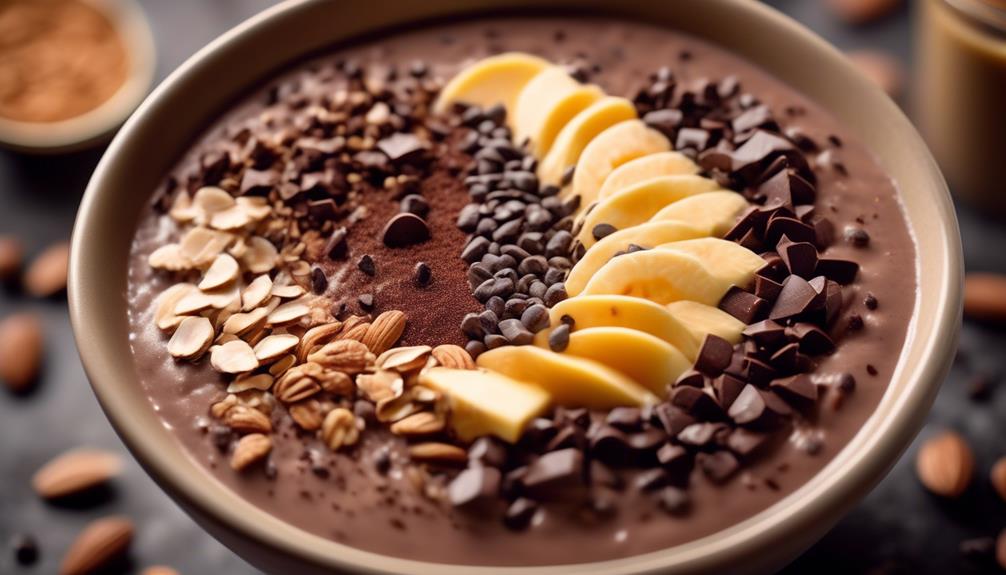
If you're a fan of chocolate and looking to keep your carb intake low, you'll be delighted to discover these delectable low-carb smoothie recipes with chocolate flavors. Not only do they satisfy your chocolate cravings, but they also provide you with essential nutrients and keep you on track with your low-carb lifestyle.
Here are three mouthwatering recipes for you to try:
- Chocolate Protein Smoothie: Blend together unsweetened almond milk, chocolate protein powder, a tablespoon of almond butter, and a handful of spinach. This smoothie isn't only low in carbs but also high in protein, which can help keep you feeling full and satisfied throughout the morning.
- Keto Chocolate Smoothie: Combine coconut milk, unsweetened cocoa powder, a tablespoon of MCT oil, and a few drops of liquid stevia. MCT oil is a source of healthy fats that can provide sustained energy and support ketosis, making this smoothie perfect for those following a ketogenic diet.
- Choco-Berry Delight: Blend together unsweetened almond milk, frozen berries, a tablespoon of unsweetened cocoa powder, and a scoop of low-carb vanilla protein powder. This smoothie isn't only rich in chocolate flavor but also packed with antioxidants from the berries.
These low-carb smoothie recipes with chocolate flavors are a delicious way to start your day while staying on track with your dietary goals. Enjoy!
Conclusion
In conclusion, low-carb breakfast smoothies are a delicious and nutritious way to start your day. By incorporating essential ingredients, choosing the right base, adding protein, and sweetening options, you can create a variety of flavors to suit your taste.
Whether you prefer leafy greens, nuts and seeds, avocado, or chocolate flavors, there's a low-carb smoothie recipe for everyone. So why not give it a try and enjoy a healthy and satisfying breakfast that will keep you energized throughout the day?
Remember, breakfast is the most important meal of the day, and with these low-carb smoothie recipes, you can make it both tasty and nutritious.


